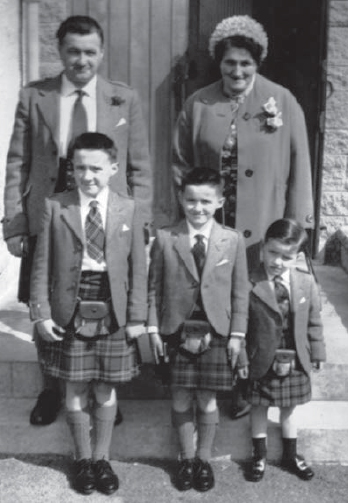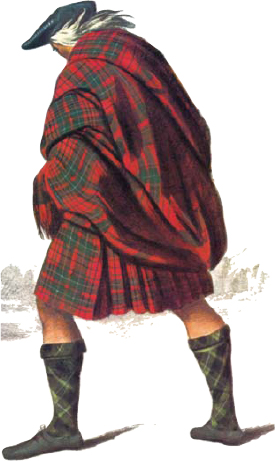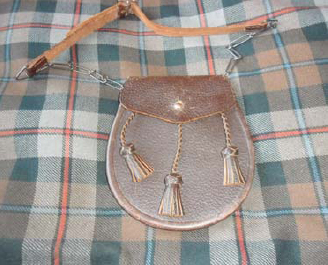
TODAY Scottish and Highland dress are very much synonymous. Indeed, it would be pretentious to argue otherwise for since 1707, first tartans and then kilts have been increasingly widely worn as a deliberate affirmation of Scottish identity.
While it may be easy to suppose that a modern Pipe Sergeant striding forth in all the wonderful majesty of tall feather bonnet, doublet, plaid, kilt, great hairy sporran and brilliant white spats bears little resemblance to the humble clansman of yesteryear, that would be to miss the point entirely. Those feather bonnets and white spats might not have been worn at Culloden, but they were certainly worn by the Sutherland Highlanders who formed the Thin Red Line at Balaclava, and before that those same feather bonnets were seen at Waterloo when the Gordons and the Scots Greys charged forward together shouting, ‘Scotland For Ever!’ This sort of thing surely confers a legitimacy all of its own and so too does the simple fact that all Scots, from the Borders to the Far North and from the Western Isles to the Lothians, have chosen for nigh on three centuries to wear the kilt or some other form of Highland dress as their national dress.
Moreover, Highland dress – or rather Scottish dress as we must call it – is not a fossilised relic of something once worn long ago and ever since preserved in aspic; it now comes in many forms and is instead very much alive, constantly changing and adapting to meet different needs and expectations.
A splendid example of this is provided by Aboyne Dress. Scottish women’s dress has not been touched upon so far for the simple reason that there appears to have been very little about it that was distinctive. There is evidence that in the eighteenth century, women sometimes wore bonnets, just like their men-folk. Sadly, if a surviving example with straps or ties and one of Edward Burt’s sketches are to be relied on, they did not wear them stylishly cocked on one side, but scrugged down flat, which argues for practicality rather than fashion. Similarly, most dresses and gowns appear to have been cut short or at least hitched up halfway between the feet and the knees, not so as to reveal well-turned ankles, but to keep the hems from dragging in the mud as they went about daily lives that were far removed from the polished floors of the gentry. This, however, was not a peculiarity of Scottish or even Highland dress, but common to all country clothing north and south of the border. Occasionally a fine tartan material might be used to make a Sunday gown, or it might be decorated with tartan ribbons, which were sometimes worn as favours, but otherwise there was nothing remarkable about the form it took except for wearing the plaid as a shawl.
The larger ones were known as Arisaids, which the Skye man, Martin Martin, helpfully described as,
… a white plaide, having a few small stripes of black, blew and red; it reached from the neck to the heels, and was tied before on the breast with a buckle of silver, or brass, according to the Quality of the person ... the plad being pleated all round, was tied with a Belt below the Breast; the Belt was of Leather, and several pieces of silver intermixed with the Leather like a Chain.

Modern Scottish dress can vary in scope and formality – or the lack of it – but this 1960s family snapped at a wedding is still a typical sight.
This description has sometimes been interpreted to mean that the predominantly white material was relieved by fine coloured stripes running in only one direction, but it is far more likely of course that Martin was really talking about tartans with the customary pattern of coloured stripes laid over a white rather than a coloured background. For a time therefore there was a tradition of weaving ‘women’s’ tartans which were identical in pattern to those worn by men except for the white background. In more recent years, however, the distinction has largely been set aside and the white tartans are now usually marketed as ‘dress tartans’ to be worn by either men or women on formal occasions indoors.
Aboyne dress was introduced in the 1970s for Highland dancing, combining practicality with a very distinctive Scottish styling.
Consequently until comparatively recently it was considered sufficient for women to wear a tartan shawl out of doors, or if dancing with a partner to wear a tartan sash or favour. In competitions, for the Highland Fling or for Sword Dancing or any other solo dance requiring something shorter than a ballgown, a curious tradition grew up of wearing men’s kilts, jackets and bonnets. However, in the 1970s the dance committee for the Aboyne Highland Games very rightly decided that this was a most unsatisfactory state of affairs. Instead an entirely new costume was devised for competitions, comprising a very full knee-length tartan skirt, a fly plaid, and a tight decorated bodice or waistcoat worn over a white blouse.
This was in all honesty a piece of pure invention, but it was also a very distinctive and unmistakeably Scottish style, and for that reason has proved a very successful one.
The importance and continuing relevance of Highland or Scottish dress can also be seen in the way in which it is worn with varying degrees of formality according to the occasion and the inclination of the wearer. It can be seen in its most colourful and spectacular form when worn by pipe bands and Highland dancers, and scarcely less formally at weddings, dinners, graduations and similar occasions. In the British Army it is only worn by Scottish regiments but Scots serving in both the Royal Navy and the Royal Air Force may wear the kilt as part of their mess kit. Similarly members of the Scout Association may wear it as part of their uniform if they are Scots or are of Scottish descent. It is de rigueur of course for Highland Games and a perfect accompaniment for tweeds, but it is not just for the high days and holy days and can be seen worn with hiking boots and sweaters as well.
And above all, whether Scottish dress takes the form of a kilt, trews, skirt or anything else, the most important and most instantly recognised feature is the tartan.
An often controversial aspect of the story of Scottish dress is the question of clan tartans. As discussed in the previous chapter, most if not all of the principal ones were to all intents and purposes ‘invented’ early in the nineteenth century. Robertson tartan, for example, first appears in William Wilson’s pattern books in 1793. Chisholm and Stewart had been added by 1800, and following the royal visit in 1822 there was a positive flood to meet a burgeoning demand. Ironically although the Sobieski Stuarts’ Vestiarium Scoticum was quickly recognised to be a forgery, a substantial number of the seventy-five tartans described in it have subsequently been adopted and firmly established as those of the clans concerned. This origin nevertheless does not affect their legitimacy: if a sett needs to be adopted or invented for a particular clan, the fact that it first appeared in the Vestiarium rather than anywhere else is quite irrelevant. Indeed it is certainly true to say that having been published as long ago as 1842 the Vestiarium tartans now enjoy a fair degree of legitimacy in their own right.
New tartans are still being created every day – sometimes for individuals, families, and regiments, and sometimes for institutions such as universities and even for states. Existing clan tartans are also being adapted in a vibrant and lively fashion not just to create dress tartans, but hunting tartans, ancient tartans and muted tartans, just as a modern football team boasts different strips for different occasions.
Slightly more controversial is the association of seemingly unrelated names with particular clans. These names are sometimes regarded as ‘septs’ or branches of the clan but not necessarily sharing the name, in order to prove ‘entitlement’ to wear a particular tartan. A polite enquiry will for example confirm that anyone named Allan, Bissett, Bowie, Buie, Gilroy, MacAllan, Macgilroy, MacKerran, MacKiaran, MacKessock, Pratt, or Suttie can be considered as members of Clan Grant. Similarly those bearing the names Allan, Allanson, Bartholomew, Callendar, Caw, Galbraith, Gruamach, Kinnieson, Lennox, MacAindra, MacAllan, MacCaa, MacCaw, MacCondy, MacEoin, MacGeoch, Macgreusich, Macinstalker, MacIock, MacJames, Mackinlay, MacNair, MacNider, MacRobb, MacWalter, MacWilliam, Miller, Monach, Napier, Parlane, Robb, Stalker, Thomason, Weaver, and Weir may consider themselves connected with Clan MacFarlane.

The plaid as a mantle or outer garment in bad weather.
In Gaelic society a man was rarely referred to as, say, Mr Grant or Mr MacFarlane – if they were all Grants or MacFarlanes in a particular locality it was obviously necessary to distinguish between them. Therefore if a man was possessed of land he was normally referred to by his address; as MacFarlane of Lennox for example, or simply as Lennox. More commonly he might be distinguished as the son of his father and thus Allan or MacAllan.
It will be noted of course that someone named Allan or MacAllan can choose to wear either Grant or MacFarlane tartan according to preference. The reason for this is quite simple, in that such patronymics were never peculiar to one particular clan. Sometimes, however, the associations can be more tenuous. A good example of this is the name Reid, one of the fifty most common surnames in Scotland. This name is held to be a sept or branch of the Clan Robertson, and that those bearing the name are accordingly entitled to wear the Robertson tartan. In reality that association arises simply from the fact that in the eighteenth century a Robertson of Straloch changed his name in order to fulfil the terms of a fortunate legacy, and was thereafter Baron Reid of Straloch. The present author’s Reid forebears therefore have no connection whatsoever with Perthshire and Clan Robertson since they have belonged to eastern Aberdeenshire at least as far back as the sixteenth century!
Not that it matters; nothing about clan tartans, save the exclusivity of the Royal Family’s private Balmoral tartan, is compulsory. Scots may choose to wear the tartan of ‘their’ clan, or they may choose to wear something entirely different, ‘according to their fancy’. Far from restricting tartan to the chosen ‘Celtic’ few, these lists are instead a reflection of the degree to which tartan is an inclusive Scottish icon, entitled to be worn by all Scots and those of Scottish descent and not just those bearing the names of the great clans. They are in short an encouragement to wear it whether one’s name is MacDonald or Smith.
By way of a tailpiece, the curious will no doubt quietly wish to know the answer to the perennial question: what is worn under the kilt?
The answer is assumed to be nothing, but yet while sometimes interpreted literally it is based on a misunderstanding. As we have seen, the plaid was not something the Scots wore instead of trousers, but an outer garment, a cloak or overcoat – and under it they did indeed wear nothing, or rather (usually) they wore no breeches but instead wandered around dressed just in their shirts. This was of course why the slightly scandalised Army put them into kilts in the first place – in order to preserve a proper soldierly appearance. Ironically the wheel eventually turned full-circle: when Highland soldiers in South Africa during the First World War were relaxing, whether during a halton the march or taking part in sports days, they were prone to taking off the heavy kilt and just wandering around in shirt tails and khaki drawers!

An essential accompaniment to Highland or Scottish dress is the sporran, of which this is a typical example. The decorative tassels originated as a simple drawstring fastening.